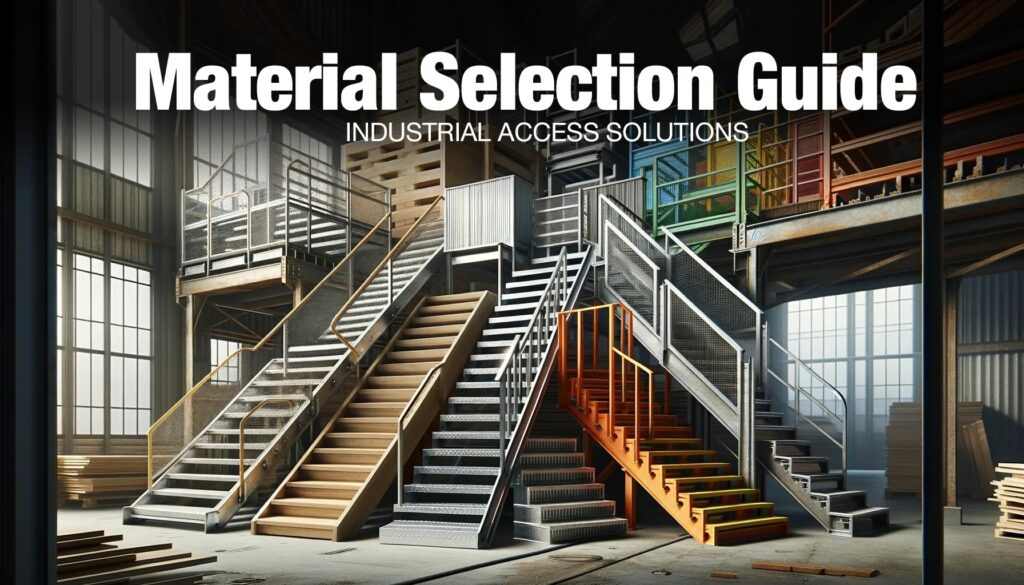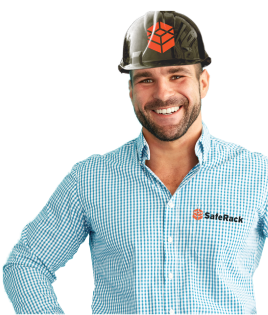
Insights on choosing the right material for your industrial projects. Our experts compare the benefits of aluminum, steel, fiberglass, and wood to help you make informed decisions that promise long-term success and sustainability.

Ray Evans, who has been with SafeRack since 2003 and currently serves as a Market Specialist, offers insights into the impact of material choices on safety, productivity, and overall business success, particularly regarding stairs and access solutions.
Contact Ray or follow him on LinkedIn
Safety Culture as the Foundation:
A robust safety culture is the key to success in any industry. It not only reduces accidents but also boosts productivity, employee morale, and overall business success. Fall protection is a critical aspect, and according to the National Safety Council, it continues to be a top concern, highlighting the need for proper safety education and equipment use.

Material Selection Matters:
When it comes to providing secure access to industrial equipment or buildings, safety should be a priority. Material selection plays a vital role in improving product longevity, reducing maintenance costs, and enhancing the overall user experience.
Wood vs. Aluminum:
- Durability: Aluminum outshines wood in durability, requiring minimal maintenance compared to the high upkeep of wood.
- Corrosion Resistance: Aluminum’s resistance to rust makes it a superior choice over wood, especially in challenging conditions.
- Ease of Assembly: Prefabricated aluminum solutions offer significant time and cost savings compared to labor-intensive wood construction.
- Strength/Weight: Aluminum, being three times stronger than wood, proves to be a more reliable choice in various applications.
- Cost: While wood may have a lower upfront cost, the long-term benefits of aluminum outweigh the initial savings.
| WOOD | ALUMINUM |
| Less Expensive Upfront | More Expensive |
| Resistant To Corrosion | Resistant To Corrosion |
| Lighter (94 lbs. per cubic foot) | Heavier (169 lbs. per cubic foot) |
| Non-Conductive | Conductive |
| Less Durable | Stronger |
| Longer Assembly Times | Easy To Assemble |
Aluminum vs. Steel:
- Durability: Steel’s strength is unmatched, but aluminum’s flexibility and lighter weight offer advantages in certain applications.
- Corrosion Resistance: Aluminum’s natural resistance to corrosion gives it an edge over steel, especially in corrosive environments.
- Weight: Aluminum’s lightweight nature makes it easier to transport and handle than the denser steel.
- Cost: While steel may have a lower cost per pound, aluminum’s advantages often justify the higher initial expense.
| STEEL | ALUMINUM |
| Cheaper | More Expensive |
| Prone To Corrosion | Resistant To Corrosion |
| Heavier (490 lbs. per cubic foot) | Lighter (169 lbs. per cubic foot) |
| Absorbs Heat | High Thermal Conductivity |
| Very Strong | Less Durable |
| Longer Assembly Time | Easy To Assemble |
Aluminum vs. Fiberglass:
- Durability: Fiberglass excels in resisting scratches and dents, while aluminum holds up better against UV exposure.
- Corrosion Resistance: Both materials offer corrosion resistance, with fiberglass excelling in certain chemical environments.
- Strength: Aluminum’s durability surpasses fiberglass, making it more suitable for impact-prone applications.
- Weight: Aluminum is heavier than fiberglass but offers comparable strength at a lower weight.
- Cost: Fiberglass tends to be more expensive than aluminum, considering both material and manufacturing costs.
| FIBERGLASS | ALUMINUM |
| Cheaper | More Expensive |
| Resistant To Corrosion | Resistant To Corrosion |
| Lighter (112 lbs. per cubic foot) | Heavier (169 lbs. per cubic foot) |
| Non-Conductive | High Thermal Conductivity |
| Prone To Breaking or Cracking | More Durable |
| Longer Assembly Time | Easy to Assemble |
Making the Right Choice:
Ultimately, the choice of material depends on the specific application. For industrial and commercial environments, wood is generally not recommended. Aluminum proves to be a versatile and cost-effective choice in most cases, while fiberglass is suitable for extreme acidic or alkaline environments.
At SafeRack, sustainability is a key consideration, with a focus on recycled materials. The decision-making process involves evaluating safety, performance, throughput, sustainability, cost, and total cost of ownership. By carefully weighing these factors, businesses can confidently select the best material for their unique and site-specific applications, ensuring both safety and efficiency.
After considering all these factors, the best choice in material for your specific application will rest on your specific needs and desired outcome. Properly considering the information in this document will help you make the best possible decision. It’s not just about one thing, it’s about all of them.
- Safety
- Performance
- Throughput
- Sustainability
- Cost
- Total cost of ownership
We at SafeRack are standing by to help you, and wish you success. If you have any questions about material selection when building your safety solutions, please reach out to a SafeRack representative.





